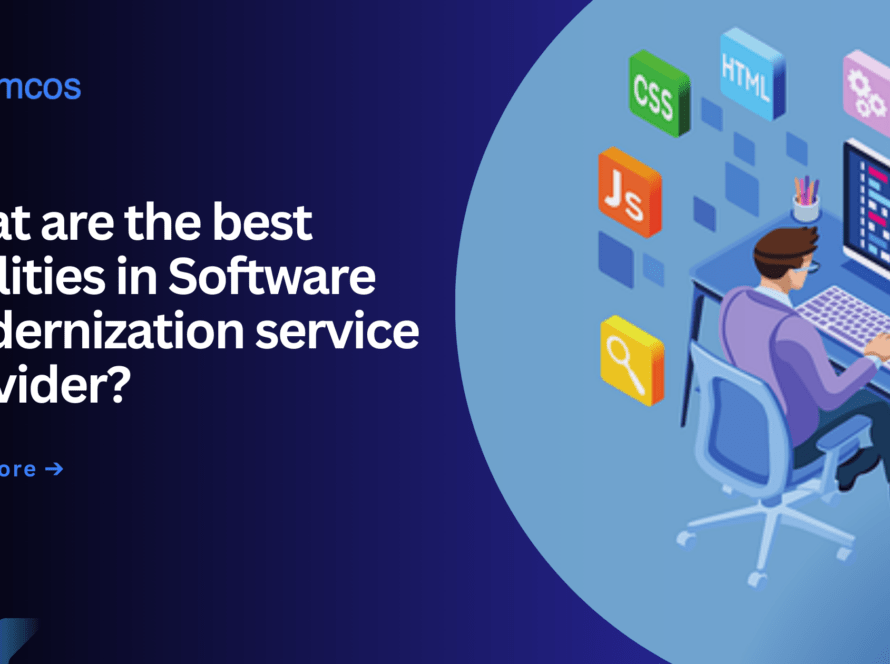Software modernization means upgrading older or outdated software systems to be able to fit current needs, trends in technology and market demands. The changeover of old systems involves code changes, redesign of applications and sometimes even migration to newer platforms or cloud services. The whole idea is to make the software operate smoother, easier to use and more secure, with lesser maintenance cost.
The salient features of software modernization include workflow automation, system integration, AI-driven machine learning, self-service portals, automated alerts, robotic process automation, cloud services, data synchronization, task scheduling and intelligent document processing. These practices have immensely helped business owners to automate a lot of the manual work, increase the efficiency of operations and stay competitive in this fast-changing world of technology.
Table of Contents
Software Modernization
Software modernization means updating and improving the business value of old software systems in order for them to meet current needs, technology trends and market requirements. Such activities enable upgrading legacy systems to make them work better, be more useful and safer, even keeping their originally established functions.
The concept of software modernization involves code modifications, application redesign and movement to newer platforms or cloud services, among other modern tools and practices. This requires making things work better, lessening maintenance cost, enhancing user experience and keeping software continually useful and competitive against the ever-changing technology landscape.
Features of Software Modernization:

Following are various software modernization features that help automate Manual Tasks:
1. Workflow Automation
Workflow automation tools enable you to create, run and manage workflows. The process is presented in the form of a flowchart drawn using graphical software. When the task is initiated, the system will simply go through the planned process step-by-step. It is done using Business Process Management tools such as, for instance, Camunda, Bizagi, or Microsoft Power Automate.
The moment a worker requests time off, it is automatically routed to an appropriate manager for approval and further automatically updates the worker’s leave balance, notifying HR without any manual intervention. This reduces errors and increases speed for processes.
2. Integration with Other Systems
Modern applications share data effectively with other business systems such as CRM, ERP and HRM. Integration Platform as a Service provides connectors and APIs for smooth interaction between different applications and the effective sharing of data. They help in data altering, process arrangement and linking of different systems. Tools on the iPaaS blueprint are MuleSoft, Dell Boomi and Azure Logic Apps.
When an order is placed within a CRM, the iPaaS platform automatically updates the inventory within an ERP (Enterprise Resource Planning) and creates an invoice in a billing system.
3. AI-based ML and Machine Learning
AI and machine learning algorithms help perform automation in tasks that require decision-making and pattern recognition. Such models learn from historical data in order to find patterns and make predictions. These are used in applications for tasks such as customer support via a chatbot deployment, fraud detection and recommendations. To go ahead with this, one requires machine learning frameworks and libraries that include TensorFlow, PyTorch and Scikit-learn, plus AI services from Google AI, AWS AI and Azure AI.
AI chatbots help answer customer service questions, giving fast answers to solving common problems. They use NLP (Natural Language Processing) to understand what customers ask and give suitable responses without needing a human.
4. Self-Service Portals
Self-service portals enable users to accomplish tasks independently, in this way reducing the workload for support staff. These portals are developed through web development tools, which enable the user to interact and communicate with the system through convenient, user-friendly interfaces. The frontend is connected with the backend system through APIs for data retrieval and manipulation and is built on web development frameworks and CMS, such as React, Angular and Drupal.
With RESTful APIs, a Human Resource portal is enabled so that employees make direct updates to their information within the HR system. They log into the HR portal to update their information, review pay stubs and request days off. On the other hand, clients use the service portal to check the status of their orders, request support and manage their accounts without direct contact with a representative.
5. Automated Alerts and Notifications
Modern applications monitor events for conditions and send out notifications or alerts when some set of criteria is reached. These apps are the tools that monitor the systems and applications for events or conditions. When a threshold limit is reached, they automatically mail alerts or send SMS or push notifications. More and more often, the apps using notification services such as Twilio, Amazon SNS, along with various monitoring tools like Nagios, Prometheus and Grafana running on Pushbullet.
Inbound logistic operations will be automated by an inventory management system capable of automatically reordering when stock levels get too low. Similarly, an IT monitoring tool will tip off administrators on possible issues before they blow out to make way for proactive management.
6. Robotic Process Automation (RPA)
RPA tools use software robots to copy what humans do on digital systems. These bots work with applications, input data, do calculations and start workflows. There are different RPA platforms like UiPath, Blue Prism and Automation Anywhere.
An RPA bot might collect data from different systems, fill out forms, create reports and send emails. This becomes very useful in invoice processing, where a bot pick data from incoming invoices that it will feed into the accounting system and start the approval for payment process.
7. Cloud Services and APIs
Utilizing the cloud services and APIs automates the processes that enable the applications to communicate with each other and take over different required tasks. If these cloud services are the big three—AWS, Azure, Google Cloud—they provide elastic infrastructure, storage and compute power that is managed using programming. The automation scripts or apps work using this API tooling, enabling the standard way of working with APIs to set up resources, back up and manage data without humans having to do that.
Cloud storage services ensure automatic saving of data at regular intervals and APIs ensure that different services communicate with one another seamlessly, eliminating the requirement for human management of the infrastructure and data transfer.
8. Data Synchronisation
Automated data synchronization ensures information consistency on all systems and platforms. Synchronization of tools helps in keeping data consistency over the systems by automatically copying and changing data. They are set up for working in real-time or at scheduled time. These services are further provided by data integration tools such as Talend, Apache Nifi and AWS Glue.
Changes made to a central database automatically propagate through all the systems using it, eliminating disparities. This is vital in maintaining data integrity and reducing manual data reconciliation.
9. Task Scheduling
Scheduling Task Scheduling software includes the scheduling by automation tools to run jobs in a set time or period without manual intervention. Their responsibilities include starting scripts, running programs and keeping processes independently. Examples of such software include such job scheduling utilities and cron for Unix/Linux systems, Windows Task Scheduler, Apache Airflow, Jenkins and other enterprise job schedulers
Put a system in place that automatically creates financial reports monthly, backups nightly, or schedules quiet-hour maintenance tasks. This way, your critical jobs will be automatically done in a consistent and dependable way without a need for human intervention.
10. Intelligent Document Processing
Tools such as OCR and NLP help in the automatic retrieval and processing of information in documents. OCR tools transform scanned documents and images into readable computer text. NLP libraries analyze that text for relevant information. Intelligent document processing platforms provide both these technologies in the simplification of tasks: data extraction, document sorting and information verification. Among the used ones are OCR tools like Tesseract and Adobe Acrobat, NLP libraries such as SpaCy and NLTK and intelligent document processing platforms such as ABBYY FlexiCapture and UiPath Document Understanding.
OCR converts scanned invoices into editable text, while NLP annotates and categorizes customer feedback. This removes much of the manual input of data by people and increases the efficiency and accuracy of document handling.
By utilizing these advanced technologies and methodologies, Software modernization transforms manual, time-consuming tasks into automated processes, enhancing overall operational efficiency and allowing staff to focus on more strategic and high-value activities.
Software modernization breathes new life into these legacy systems, making them efficient, useful and meeting the standards of today’s technology. With advanced features like workflow automation, system integration, AI and ML, self-service portals, robotic process automation, businesses streamline operations—which are otherwise manual—enhancing user experiences and reducing manual efforts.
Cloud services, data syncing, task scheduling and smart handling of documents make operations smooth, data-driven and timely. Modern tools and practices ensure that things do not just work better but become a way for companies to keep their noses ahead in a fast market of changes. In brief, software renovation transforms yesterday’s inflexible system into one that is changeable and high-performing, fit to assist in the development and innovation of enterprises.

Himcos provides Business Software Modernization services. Our team isn’t just skilled, you get the best minds tackling your modernization project, ensuring exceptional quality and results. Our experts help improve performance, reduce costs, enhance security and foster innovation providing our clients with scalable, secure and high performing application



